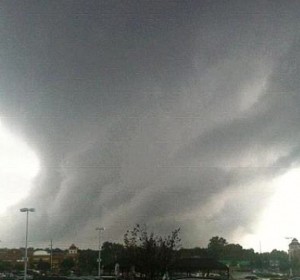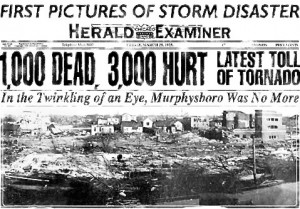Note: This novel has been named one of the Ten Best Debut Novels of 2013 by Booklist.
“How does a man greet people he’s known all his life when they’re standing in his house because they’ve lost something, lost everything perhaps, and he has not…How do you look at neighbors and former schoolmates when you know that tomorrow morning, they’ll be buying wood from you for coffins.” Paul Graves, on the night of the tornado.
 One of the best debut novels I have read in a long time, Falling to Earth focuses on the aftermath of the largest and most powerful tornado ever to hit the United States, one known as the Tri-State Tornado of March 18, 1925, which traveled two hundred nineteen miles through northeast Missouri, across southern Illinois, and into southwest Indiana over the course of three hours eighteen minutes. Destroying everything in its path, it killed almost seven hundred people. Author Kate Southwood describes the aftermath of this storm in the town of Marah, Illinois, a rural composite of all the communities hit by this horrific storm. What elevates this novel above a journalistic report of buildings destroyed and communities devastated is Southwood’s focus on the effects of the tornado on one family – not the inspiring survival story of a family that has lost everything, as one might expect, but the story of a family that has lost nothing, their children safe, their home undamaged, and their lumber business intact.
One of the best debut novels I have read in a long time, Falling to Earth focuses on the aftermath of the largest and most powerful tornado ever to hit the United States, one known as the Tri-State Tornado of March 18, 1925, which traveled two hundred nineteen miles through northeast Missouri, across southern Illinois, and into southwest Indiana over the course of three hours eighteen minutes. Destroying everything in its path, it killed almost seven hundred people. Author Kate Southwood describes the aftermath of this storm in the town of Marah, Illinois, a rural composite of all the communities hit by this horrific storm. What elevates this novel above a journalistic report of buildings destroyed and communities devastated is Southwood’s focus on the effects of the tornado on one family – not the inspiring survival story of a family that has lost everything, as one might expect, but the story of a family that has lost nothing, their children safe, their home undamaged, and their lumber business intact.
 As Paul Graves, owner of Graves Lumber, hurries home to check on his family after the storm, having saved himself by hugging the base of a telephone pole as the funnel cloud hit, he hears wailing and screaming, people calling out names or crying for help. Bodies lie everywhere, automobiles are overturned, and a woman is “frozen, screaming under a tree, a child’s body caught high in its branches.” Paul’s children, he realizes, have escaped the fate of those killed in the collapse of the elementary school; they were home with the chicken pox. The rest of the family – Paul’s wife Mae and his mother Lavinia – have also escaped death having had time to reach the basement shelter that Paul built.
As Paul Graves, owner of Graves Lumber, hurries home to check on his family after the storm, having saved himself by hugging the base of a telephone pole as the funnel cloud hit, he hears wailing and screaming, people calling out names or crying for help. Bodies lie everywhere, automobiles are overturned, and a woman is “frozen, screaming under a tree, a child’s body caught high in its branches.” Paul’s children, he realizes, have escaped the fate of those killed in the collapse of the elementary school; they were home with the chicken pox. The rest of the family – Paul’s wife Mae and his mother Lavinia – have also escaped death having had time to reach the basement shelter that Paul built.
 Soon the Graves’ front porch has become a makeshift morgue as over a dozen bodies are brought there, many of them as-yet-unidentified children, and Mae and Lavinia quickly get to work tearing up sheets to cover them, pulling down the window shades so that Mae’s three young children will not see the horrors. Those survivors who have no place to go gather what they can and begin walking down the street with their children. “[The children] see what the adults cannot; that one is responsible to a beating heart, that the simple act of walking means moving forward in more than just the literal sense, and that even the act of reaching into the wreckage of a house to save a book or a tea kettle is a kind of beginning.”
Soon the Graves’ front porch has become a makeshift morgue as over a dozen bodies are brought there, many of them as-yet-unidentified children, and Mae and Lavinia quickly get to work tearing up sheets to cover them, pulling down the window shades so that Mae’s three young children will not see the horrors. Those survivors who have no place to go gather what they can and begin walking down the street with their children. “[The children] see what the adults cannot; that one is responsible to a beating heart, that the simple act of walking means moving forward in more than just the literal sense, and that even the act of reaching into the wreckage of a house to save a book or a tea kettle is a kind of beginning.”
The Graves family is unique, the only ones in the community who have escaped the tornado, unscathed. Paul quickly returns to the lumberyard and begins to make the dozens of coffins that will be needed in the coming week. He and Mae open their house to those who have no place to sleep until the Red Cross arrives and erects a  tent city. It is Mae, however, who points out why the neighbors are in a hurry to leave their house as soon as possible. Paul is no longer “the man with everything to share, he’s just the man with everything,” a condition which soon begins to cause resentment among the townspeople. Unable to understand the random nature of the storm, they soon begin focus on “why him?” Even small things such as Paul’s cleaning of debris from his yard leads to snide comments, such as “Nothing to rebuild, so he prettied up his yard.” The family tries to blend in as much as possible, and they refuse to plant flowers in the spring or even put up the porch swing, but to no avail. The resentment grows as the community slowly realizes how much they have lost in comparison to the fortunate Paul Graves.
tent city. It is Mae, however, who points out why the neighbors are in a hurry to leave their house as soon as possible. Paul is no longer “the man with everything to share, he’s just the man with everything,” a condition which soon begins to cause resentment among the townspeople. Unable to understand the random nature of the storm, they soon begin focus on “why him?” Even small things such as Paul’s cleaning of debris from his yard leads to snide comments, such as “Nothing to rebuild, so he prettied up his yard.” The family tries to blend in as much as possible, and they refuse to plant flowers in the spring or even put up the porch swing, but to no avail. The resentment grows as the community slowly realizes how much they have lost in comparison to the fortunate Paul Graves.

Board driven through post during Tri-State Tornado
Southwood hits exactly the right notes and exactly the right level of detail as she describes the reactions of individual members of the Graves family to their new and unwelcome role in the community, even as she paints a surprisingly empathetic picture of some townsfolk who see Paul Graves as a person who does not deserve his good fortune. As the town buries the dead with coffins built by Paul and begins to rebuild houses and businesses with Graves lumber, the resentment grows. Mae’s appearance in the line for food causes comments, though there is nowhere else she can get milk or staples. The local minister, ignorant of the deepest feelings of the congregation, gives public thanks in church for “the miracle of the Graves family, who alone among us suffered no loss of any kind,” and none of the local pastors seem to know what to say to their parishioners to explain the random nature of the disaster. As dozens of people come to gawk in front of their house after the disaster, Paul shows some of his own insensitivity, commenting to his mother that “This house is acting like a beacon. It’s a reminder of what they all had before the storm and what they have to work towards now they’ve lost it…Doesn’t that give me a duty to act a certain way?”
Southwood details the slow progress of rebuilding the community in the summer of 1925, and then in the winter of 1926, but the rebuilding is paralleled by the continued deterioration in the community’s attitudes towards the Graves family and even toward each other. Neighbor begins to turn against neighbor as they compare insurance settlements and the awards to some of the uninsured from the Red Cross. Gradually, the Graves family, including the children, become boxed in – isolated emotionally, not just from the community but from each other. The depth of their trauma and their inability to avoid it become even more understandable as Southwood vividly reconstructs the past life of each of the adults, Mae’s early family life, Lavinia’s marriage to her late husband Homer, and Paul’s courtship and marriage to Mae. The reasons for their personal isolation and their unwillingness to talk with each other about their real feelings become clearer as Southwood sets the scene for the novel’s conclusion.
The novel’s fast pace, a direct result of the author’s ability to present details with which the reader will identify, combined with her careful building of the “case” against the Graves family, make this a novel which few will forget. The town “Marah” means “bitterness,” and bitterness is a major theme here. There are no easy answers, no blame, Southwood insists, as she emphasizes the random nature of the tornado. What happened to Marah and to the Graves family could happen to anyone. The conclusion, which some may find artificial, may be justified for others in view of the characters and their personal problems, a deeply ironic conclusion which gives emphasis to the themes.
Photos, in order: The author’s photo is from https://twitter.com/katesouthwood
The funnel cloud photo appears on http://abclocal.go.com
The original newspaper report from March 18, 1925: http://en.wikipedia.org
A story on the power of the storm, shown in the board driven through a post, may be found here: http://epod.usra.edu
The graphic of the track of the Tri-State Tornado comes from http://karpathiaguide.webs.com
ARC: Europa

